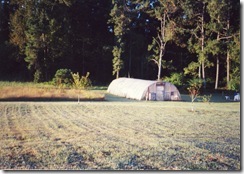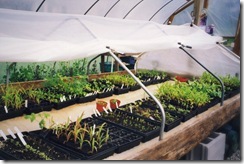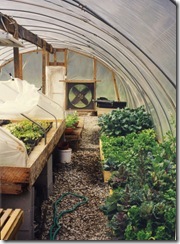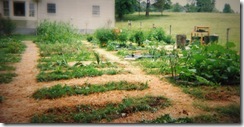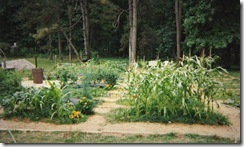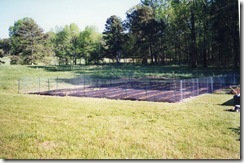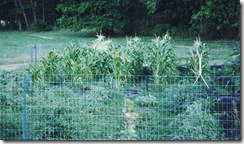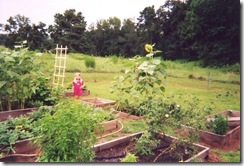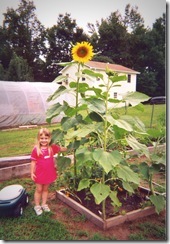The weather and scenery could not be more delightful this month in NE Georgia! Beautiful fruit blossoms and fresh new leaves color the landscape, along with the not-so-welcome pollen shower that coats vehicles with the characteristic greenish-yellow powder. I empathize with those who stay inside because of allergies during this first glimpse of spring. I am not sensitive to tree pollen, but when the grass pollen hits on May 1st (prime growing time here), I retreat to the air conditioned house and emerge only to water plants as needed. Thankfully, the grass pollen clears up in this area around the first week in June.
Because of the pollen issue, I like to do all sowing and transplanting throughout the month of April. Also, the danger of frost has passed. So, this week I am preparing pots and seed trays, and my husband and I are tweaking the design we’d like to use for our bin garden.
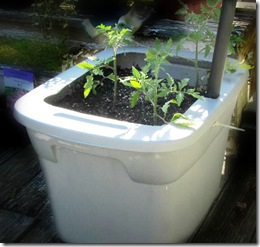 This is a picture of our first homemade self-watering container. We used an 18-gallon Sterilite tote (Wal-Mart had the best price ($5) when we bought these for our move two years ago). They might cost around $6 now. I later learned from the Sterilite website that their products (including these solid colored bins) are made of “polypropylene and polyethylene that are safe for food storage. No PVCs, Latex, Teflon, Phthalates chemicals, fungicides, Bisphenol A (BPAs), or antibacterial chemicals are used in our manufacturing process” (http://www.sterilite.com/general_info.html ). I feel this is a safer choice for growing food than Rubbermaid or other similar plastic bins. Rubbermaid states on their website under the FAQ “Product Health and Safety” section that their storage bins are not food-grade safe (http://www.rubbermaid.com/supportCenter/Pages/FAQs.aspx?TopicID=4) . In other words, if there are potentially toxic chemicals (unsafe for food storage), and the bin is not UV-stable, UV rays and heat could cause some of the chemicals to leach into the soil or water if using a container with a water reservoir. I wouldn’t want to grow a potential food source where harmful chemicals may be present. We do have some Rubbermaid bins leftover from our move, and I may use these for flower bulbs and other non-edible garden plants such as fragrant herbs and flowers for arranging, pressing, and crafts.
This is a picture of our first homemade self-watering container. We used an 18-gallon Sterilite tote (Wal-Mart had the best price ($5) when we bought these for our move two years ago). They might cost around $6 now. I later learned from the Sterilite website that their products (including these solid colored bins) are made of “polypropylene and polyethylene that are safe for food storage. No PVCs, Latex, Teflon, Phthalates chemicals, fungicides, Bisphenol A (BPAs), or antibacterial chemicals are used in our manufacturing process” (http://www.sterilite.com/general_info.html ). I feel this is a safer choice for growing food than Rubbermaid or other similar plastic bins. Rubbermaid states on their website under the FAQ “Product Health and Safety” section that their storage bins are not food-grade safe (http://www.rubbermaid.com/supportCenter/Pages/FAQs.aspx?TopicID=4) . In other words, if there are potentially toxic chemicals (unsafe for food storage), and the bin is not UV-stable, UV rays and heat could cause some of the chemicals to leach into the soil or water if using a container with a water reservoir. I wouldn’t want to grow a potential food source where harmful chemicals may be present. We do have some Rubbermaid bins leftover from our move, and I may use these for flower bulbs and other non-edible garden plants such as fragrant herbs and flowers for arranging, pressing, and crafts. Neither the Sterilite nor Rubbermaid storage bins are meant to last indefinitely when exposed to outdoor conditions year-round. I have read differing opinions regarding the longevity of these containers when used outside. My goal is to try to use ours for 4 years before they start breaking down. The majority of our bins are light silver which should work well for the hot summers in GA (protecting the roots from “baking” in the heat). Darker bins should work well in climates with mild summers where gardeners want to expedite the soil-warming process in spring and extend the growing season in the fall.
Using a storage bin as a planter is not an original idea, but a modification of the popular Earthbox®, GrowBox, Global Buckets, and EarthTainer systems. YouTube has many videos on various ways to create a self-watering container from storage bins and 5-gallon buckets. After viewing approximately 35 videos, I jotted down the ideas I liked best and discussed the possibilities for our 18-gallon bins with my husband. We both liked the idea of eliminating the extra steps of excessive drilling, sawing, and cutting, if it would not negatively impact the efficiency of the system or ultimately compromise the health of the plant. We also prefer to not be wasteful of materials. Some gardeners use two bins to create one container, throwing out part of the second container. This would cost twice as much as the one-bin method and would create unnecessary waste.
Frugality is also important to me in this project. As much as I love the idea of reducing the weeds, pests, and disease problems that may come with planting in the ground, I do not wish to replace ground planting with an expensive container gardening method. Basically, I am seeking a simple, safe, inexpensive, non-wasteful way to recycle our bins as planters. If you happen to have food-grade 5-gallon buckets available, or extra reusable shopping bags, these would make great planters as well.
A word of caution about using fabric shopping bags to grow food: These bags have been distributed to stores all over the world in an effort to reduce the amount of plastic shopping bags being used. They typically are sold for around $1 in the US, and are a sturdy, porous, and lightweight option for holding soil. There is aeration on all sides which is great for root systems and for drainage. I have not experimented with gardening in these “green” bags yet. I read that several major chain stores had recalled their reusable bags because of high lead content (http://www.usatoday.com/money/industries/retail/2011-01-23-reusable-bags_N.htm). Also, bags that have been used to carry raw meat should be washed in a bleach solution to kill harmful bacteria before growing food (actually, it is recommended that they be washed after every grocery trip). I believe that these bags, if made of natural materials (jute, organic cotton, hemp, or canvas) with no print and no bottom insert or a lead-free insert, would make excellent garden containers, especially for developing nations. These would be inexpensive to ship in large quantities and would work well with heavier garden soil, given the porosity of the bags. I am watching and learning about this topic from the innovative folks at Global Buckets (http://www.globalbuckets.org/p/grow-bags.html).
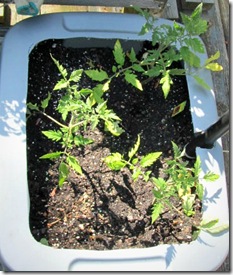
The materials we used to create our first planter are: one silver Sterilite18-gallon bin ($6), two 9-ounce plastic Solo or Hefty cups with holes drilled in the sides and bottom of the cups (approximately 10 cents for two), three 3-inch- high sections of 4”-diameter PVC pipe (approx. 93 cents – we purchased an 8-foot pipe from Home Depot for just under $9, then cut off 9” for the first bin), a hollow plastic leg saved from a plastic shelf for a watering tube (we may use PVC or a length of an old garden hose later – need to research the safety of these), and 2 cubic feet of Miracle Grow potting mix (not the moisture control formula) ($13). A less expensive alternative to buying bagged potting mix is to make your own potting mix with one part perlite, one part peat moss, and five parts compost (add small amount of lime if growing tomatoes). I have found that garden soil or topsoil is too heavy for plastic container gardening.
Because we already have the bins, and because we plan to use the soil mix for 4 years (amending it each year), we decided to splurge on a pre-mixed potting medium. One could spend $7 on each homemade planter (without potting mix), or less if you already have the supplies on hand. For a price comparison of homemade containers versus company-made, Earthbox® sells the original Earthbox system (container, aeration screen, watering tube, and plastic mulch sheets) for $33 each, plus $10 shipping. Their container also holds 2 cubic feet of potting mix (purchased separately) (http://www.earthbox.com/The-Original-EarthBox/products/52/) . This is a well-established company with an informative website. Their original product has helped people all over the world, and has sparked many ideas for creating self-watering containers from the frugal do-it-yourself crowd!
Please check back soon for pictures and instructions on our finalized self-watering design we will use for the rest of our bins.
Blessings on your gardening!
Karen

